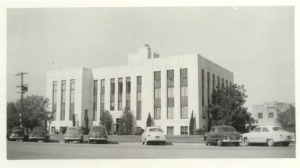
Jack County Courthouse as seen in 1940 after the dedication and re-enactment trial of Satanta and Big Tree, Kiowa Chiefs convicted of murder in 1871. The original verdict was commuted. Descendants of the original jurors and defendants participated, with Native Americans finally allowed to tell their version of the event.
County courthouse dedications were times of great celebration throughout the state of Texas. Everyone in the county turned out for the occasion that usually included lengthy speeches by prominent speakers, lots of food and reminisces, and local entertainment. They lasted at least one full day and sometimes extended over two or three days. In 1940 Jack County held a most unusual courthouse dedication for a crowd estimated to be between 20,000 and 30,000. Since there were only 10,206 people living in Jack County according to the U. S. Census in 1940, that was quite a celebration.
At the time of the dedication, newspaper accounts reported traffic was six cars wide around the square. Traffic into Jacksboro was backed up six miles to the community of Maryetta. What drew such attention throughout the nation to this small town in north central Texas? Simply put, the dedication included a re-enactment of a famous trial held sixty-nine years earlier. That was the first trial of non-citizen Native Americans with the rank of chief for the murder of seven teamsters killed in the raid west of town.
In the spring of 1871 General William T. Sherman with his entourage of seventeen Buffalo Soldiers passed Cox Mountain near Salt Creek four miles west of Jack County in Young County. On the last leg of an inspection of conditions of the Texas frontier, no one noticed the large band of Kiowa Indians hidden among the brush. Indian depredations caused evacuation of the area some five or six years earlier. All records from Young County were now in Jacksboro, home of Fort Richardson and county seat of Jack County. By dark, Sherman and his men arrived at the fort only to be shocked by two survivors bringing the tragic news of the massacre of seven teamsters in a wagon train. The raid occurred within a few hours after Sherman and his men passed there.
Sherman immediately ordered Colonel R. S. McKenzie and twenty troopers to search for the miscreants. Twenty days later McKenzie and his men arrived empty-handed at Fort Sill where Indian Agent Laurie Tatum learned that Satanta, Satank, and Big Tree, all Kiowa chiefs led the raid on the wagon train. All three were taken back to Jacksboro for trial; however, Satank was killed on the way while attempting to escape.
The trial began on July 7, 1871. The jury found the men guilty and sentenced them to hang. But Texas Governor E. J. Davis computed the verdict, saying it would incite more deadly violence in the region.
Jack County citizens wanted the Kiowa descendants to have the opportunity to tell the Native American side of the disaster. The Kiowa people faced descendants of the original jurors and told the other side of the story. In the end, event planners felt the re-enactment “marked the beginning of an era of better relationships” according to local newspaper accounts.
Today Jacksboro is a quiet, small community between Wichita Falls and Fort Worth. The courthouse still reigns over the commercial district as it has since 1940. Located in the center of town surrounded by a spacious lawn and wide streets, the structure is the work of Herbert Voelcker and Jesse Dixon of Wichita Falls, a well-known architectural firm involved in the design of public buildings and individual homes beginning in 1918. Listed today on the National Register of Historic Places, the building is an outstanding example of Modern Classical architecture.
Fort Richardson is just south of town, partially restored to its original state. However, you will need a good compass, map and GPS to locate Cox Mountain. A small bronze plaque does mark the site of the Warren Wagon Train Massacre.

Enjoyed this blog. My website has nothing to do with Jack County, however. I was born and raised in the county. My father, Leon Hawkins, was the local funeral director at the Hawkins Funeral Home, which he established in the early 1940s.
In 1957 the centennial of the founding of Jack County, Leon put together a reenactment of the Warren Wagon Train Massacre, and invited Indians from the reservation near Fort Sill in Oklahoma to come down and participate in the event. It was staged it what became Lake Jacksboro, of course it was empty then, and people watched the action from the banks above. I would dearly love to find more information about that event.
Jim, I remember you. I was at one time Carol Coley and was in Jill Hawkin’s class. I think you were a little younger, aren’t you? My cousin, Sherry King Cherryhomes lives in your old house on Belknap Street.
I remember the reenactment of the Warren Wagon Train Massacre. I think it happened in 1949 or 1950 when the lake was first built. I vividly remember a Native American nearly running over me with his horse, of course when you are five or six, any horse nearby would scare you. Everyone was so excited about the lake, they capped all the wells in town. When the drought of the 1950s started, water was strictly rationed. If I find any more out, I will let you know.